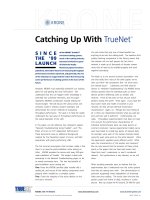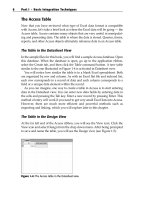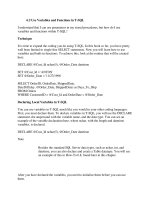Tài liệu Beginning JavaScript and CSS Development with jQuery ppt
Bạn đang xem bản rút gọn của tài liệu. Xem và tải ngay bản đầy đủ của tài liệu tại đây (10.28 MB, 560 trang )
Updates, source code, and Wrox technical support at www.wrox.com
Beginning
JavaScript
®
and CSS
Development with
jQuery
Richard York
With full-color code and illustrations
Full Color
Beginning
JavaScript
®
and CSS Development with
jQuery
www.wrox.com
$44.99 USA
$53.99 CAN
Wrox Beginning guides are crafted to make learning programming languages and technologies easier than you think, providing
a structured, tutorial format that will guide you through all the techniques involved.
Recommended
Computer Book
Categories
Programming Languages
JavaScript and VBScript
ISBN: 978-0-470-22779-4
jQuery allows you to do more in the world of dynamic web applications, with less code
and fewer errors. It reduces the amount of JavaScript programming to only a few lines
of code while making your JavaScript more intuitive and attractive to work with. At the
same time, jQuery makes it easier to manipulate CSS from JavaScript by allowing you
to set style for one or many elements at once.
With this unique, project-oriented book, author Richard York teaches even the most
novice of JavaScript users how to quickly get started utilizing the JavaScript jQuery
Library to decrease the amount of code that needs to be written and tested. A four-
color code syntax highlighting system provides a visual reinforcement and allows you
to see the nuts and bolts that comprise each line and section of code. With this helpful
guide and hands-on exercises, you’ll be able to put jQuery to work for you and avoid
having to write code from scratch.
What you will learn from this book
● How to install and test jQuery
● Techniques to manipulate content and attributes
● Ways to filter and map a selection or an array
● The difference between GET and POST
● How to easily show, hide, slide, and fade elements with smooth animations and
transitions
● Good practice for jQuery plugin development
● Methods for making elements draggable
● Ways to customize sortable lists
● How to implement and localize a datepicker
Who this book is for
This book is for web designers eager to do more with their web-based applications,
but who do not necessarily have much JavaScript experience. Some basic knowledge
of XHTML and CSS is necessary.
Enhance Your Knowledge
Advance Your Career
JavaScript
®
and CSS Development with
jQuery
York
Beginning
spine=1.0646"
Wrox Programmer to Programmer
TM
Wrox Programmer to Programmer
TM
www.it-ebooks.info
23642ffirs.indd 4 5/4/09 12:57:35 PM
www.it-ebooks.info
Beginning JavaScript
®
and
CSS Development with jQuery
Introduction xix
Part I: jQuery API 1
Chapter 1: Introduction to jQuery 3
Chapter 2: Selecting and Filtering . . . . . . . . . . . . . . . . . . . . . . . . . . . . . . . . 27
Chapter 3: Events . . . . . . . . . . . . . . . . . . . . . . . . . . . . . . . . . . . . . . . . . . . . 69
Chapter 4: Manipulating Content and Attributes 95
Chapter 5: Arrays and Iteration . . . . . . . . . . . . . . . . . . . . . . . . . . . . . . . . . 165
Chapter 6: CSS 207
Chapter 7: AJAX . . . . . . . . . . . . . . . . . . . . . . . . . . . . . . . . . . . . . . . . . . . . 219
Chapter 8: Effects 277
Chapter 9: Plugins 285
Part II: jQuery UI 297
Chapter 10: Implementing Drag-and-Drop 299
Chapter 11: Drag-and-Drop Sorting 327
Chapter 12: Selection by Drawing a Box 355
Chapter 13: Accordion UI 373
Chapter 14: Datepicker 393
Chapter 15: Dialogs 409
Chapter 16: Tabs 425
Appendix A: Answers to Exercises . . . . . . . . . . . . . . . . . . . . . . . . . . . . . . . 439
Appendix B: Selectors Supported by jQuery . . . . . . . . . . . . . . . . . . . . . . . . 447
Appendix C: Selecting and Filtering . . . . . . . . . . . . . . . . . . . . . . . . . . . . . . 451
Appendix D: Events 453
Appendix E: Manipulating Attributes and Data Caching 457
Appendix F: Manipulating Content . . . . . . . . . . . . . . . . . . . . . . . . . . . . . . . 459
Appendix G: AJAX Methods 461
Appendix H: CSS 465
Appendix I: Utilities 467
Appendix J: Draggables and Droppables 469
Appendix K: Sortables 475
27794ffirs.indd 1 3/16/09 3:14:20 PM
www.it-ebooks.info
Appendix L: Selectables. . . . . . . . . . . . . . . . . . . . . . . . . . . . . . . . . . . . . . . 479
Appendix M: Effects . . . . . . . . . . . . . . . . . . . . . . . . . . . . . . . . . . . . . . . . . 481
Appendix N: Accordion 485
Appendix O: Datepicker 487
Appendix P: Dialog . . . . . . . . . . . . . . . . . . . . . . . . . . . . . . . . . . . . . . . . . . 497
Appendix Q: Tabs 501
Appendix R: Re-Sizables . . . . . . . . . . . . . . . . . . . . . . . . . . . . . . . . . . . . . . 505
Appendix S: Sliders . . . . . . . . . . . . . . . . . . . . . . . . . . . . . . . . . . . . . . . . . . 509
Index 511
27794ffirs.indd 2 3/16/09 3:14:20 PM
www.it-ebooks.info
Beginning
JavaScript
®
and CSS Development with jQuery
27794ffirs.indd 3 3/16/09 3:14:20 PM
www.it-ebooks.info
27794ffirs.indd 4 3/16/09 3:14:20 PM
www.it-ebooks.info
Beginning
JavaScript
®
and CSS Development with jQuery
Richard York
27794ffirs.indd 5 3/16/09 3:14:20 PM
www.it-ebooks.info
23642ffirs.indd 4 5/4/09 12:57:35 PM
www.it-ebooks.info
Beginning JavaScript
®
and CSS Development with jQuery
Published by
Wiley Publishing, Inc.
10475 Crosspoint Boulevard
Indianapolis, IN 46256
www.wiley.com
Copyright © 2009 by Wiley Publishing, Inc., Indianapolis, Indiana
Published simultaneously in Canada
ISBN: 978-0-470-22779-4
Manufactured in the United States of America
10 9 8 7 6 5 4 3 2 1
Library of Congress Cataloging-in-Publication Data
York, Richard.
Beginning JavaScript and CSS development with jQuery / Richard York.
p. cm.
Includes index.
ISBN 978-0-470-22779-4 (paper/website)
1. JavaScript (Computer program language) 2. Web sites Design. 3. Cascading style sheets. I. Title.
QA76.73.J38Y67 2009
006.7’6 dc22
2009005636
No part of this publication may be reproduced, stored in a retrieval system or transmitted in any form or by any means,
electronic, mechanical, photocopying, recording, scanning or otherwise, except as permitted under Sections 107 or 108
of the 1976 United States Copyright Act, without either the prior written permission of the Publisher, or authorization
through payment of the appropriate per-copy fee to the Copyright Clearance Center, 222 Rosewood Drive, Danvers, MA
01923, (978) 750-8400, fax (978) 646-8600. Requests to the Publisher for permission should be addressed to the Permissions
Department, John Wiley & Sons, Inc., 111 River Street, Hoboken, NJ 07030, (201) 748-6011, fax (201) 748-6008, or online at
/>.
Limit of Liability/Disclaimer of Warranty: The publisher and the author make no representations or warranties with
respect to the accuracy or completeness of the contents of this work and specifically disclaim all warranties, including
without limitation warranties of fitness for a particular purpose. No warranty may be created or extended by sales or pro-
motional materials. The advice and strategies contained herein may not be suitable for every situation. This work is sold
with the understanding that the publisher is not engaged in rendering legal, accounting, or other professional services. If
professional assistance is required, the services of a competent professional person should be sought. Neither the publisher
nor the author shall be liable for damages arising herefrom. The fact that an organization or Web site is referred to in this
work as a citation and/or a potential source of further information does not mean that the author or the publisher endorses
the information the organization or Web site may provide or recommendations it may make. Further, readers should be
aware that Internet Web sites listed in this work may have changed or disappeared between when this work was written
and when it is read.
For general information on our other products and services please contact our Customer Care Department within the
United States at (877) 762-2974, outside the United States at (317) 572-3993 or fax (317) 572-4002.
Trademarks: Wiley, the Wiley logo, Wrox, the Wrox logo, Programmer to Programmer, and related trade dress are trade-
marks or registered trademarks of John Wiley & Sons, Inc. and/or its affiliates, in the United States and other countries,
and may not be used without written permission. JavaScript is a registered trademark of Sun Microsystems, Inc. All other
trademarks are the property of their respective owners. Wiley Publishing, Inc., is not associated with any product or vendor
mentioned in this book.
Wiley also publishes its books in a variety of electronic formats. Some content that appears in print may not be available in
electronic books.
27794ffirs.indd 6 3/16/09 3:14:20 PM
www.it-ebooks.info
About the Author
Richard York is a web developer and author of three Wrox books in addition to this: Beginning CSS:
Cascading Style Sheets for Web Design (Wiley, 2007), CSS Instant Results (Wiley, 2006), and Beginning CSS:
Cascading Style Sheets for Web Design, 2nd ed (Wiley, 2007).
Website:
www.deadmarshes.com
27794ffirs.indd 7 3/16/09 3:14:20 PM
www.it-ebooks.info
27794ffirs.indd 8 3/16/09 3:14:20 PM
www.it-ebooks.info
Credits
Senior Development Editor
Tom Dinse
Technical Editor
Sam Judson
Senior Production Editor
Debra Banninger
Copy Editor
Cate Caffrey
Editorial Manager
Mary Beth Wakefield
Production Manager
Tim Tate
Vice President and Executive Group Publisher
Richard Swadley
Vice President and Executive Publisher
Barry Pruett
Associate Publisher
Jim Minatel
Project Coordinator, Cover
Lynsey Stanford
Compositor
James D. Kramer,
Happenstance Type-o-Rama
Proofreader
Nancy Carrasco
Indexer
J & J Indexing
27794ffirs.indd 9 3/16/09 3:14:20 PM
www.it-ebooks.info
27794ffirs.indd 10 3/16/09 3:14:20 PM
www.it-ebooks.info
Contents
Introduction xix
Part I: jQuery API 1
Chapter 1: Introduction to jQuery 3
What Does jQuery Do for Me? 4
Who Develops jQuery? 5
Obtaining jQuery 5
Installing jQuery 5
Programming Conventions 8
XHTML and CSS Conventions 9
JavaScript Conventions 16
Summary 25
Chapter 2: Selecting and Filtering 27
The Origin of the Selectors API 28
Using the Selectors API 29
Filtering a Selection 37
Searching within a Selection with
find()
38
Finding an Element’s Siblings with
siblings()
39
Selecting Specific Siblings 42
Searching Ancestors Using the
parents()
and
parent()
Methods 46
Selecting Children Elements 48
Selecting Elements via What You Don’t Want 50
Selecting a Snippet of the Results 51
Adding More Elements to a Selection 53
Selecting One Specific Element from a Result Set 55
Summary 66
Exercises 66
Chapter 3: Events 69
Assigning an Event with the Traditional Event Model 69
Assigning Events with the W3C Event Model 72
The
this
Object 73
The
event
Object 75
www.it-ebooks.info
xii
Contents
The Microsoft JScript Event Model 77
Creating a Universal Event API 78
Binding Events with jQuery’s
bind()
Method 80
Binding Events with jQuery’s Event Methods 82
Triggering Events 83
Summary 93
Exercises 93
Chapter 4: Manipulating Content and Attributes 95
Setting and Accessing Attributes 95
Manipulating Class Names 105
Manipulating HTML and Text Content 109
Getting, Setting, and Removing Content 110
Appending and Prepending Content 115
Inserting Beside Content 123
Inserting Beside Content via a Selection 125
Wrapping Content 129
Replacing Elements 146
Removing Content 150
Cloning Content 154
Summary 162
Exercises 163
Chapter 5: Arrays and Iteration 165
Basic Iteration 165
Calling
each()
Directly 167
Variable Scope 168
Emulating
break
and
continue
170
Iterating a Selection 172
Filtering Selections and Arrays 173
Filtering a Selection 174
Filtering a Selection with a Callback Function 175
Filtering an Array 177
Mapping a Selection or an Array 180
Mapping a Selection 180
Mapping an Array 183
Array Utility Methods 196
Making an Array 197
Finding a Value within an Array 197
www.it-ebooks.info
xiii
Contents
Merging Two Arrays 198
Removing Duplicate Items 199
Summary 204
Exercises 205
Chapter 6: CSS 207
The
css()
Method 207
The
outerWidth()
and
outerHeight()
Methods 208
Summary 217
Exercises 217
Chapter 7: AJAX 219
Making a Server Request 220
What’s the Difference between GET and POST? 220
Formats Used to Transport Data with an AJAX Request 221
Making a
GET
Request with jQuery 222
Loading HTML Snippets from the Server 240
Dynamically Loading JavaScript 265
AJAX Events 267
Making an AJAX-Style File Upload 272
Summary 275
Exercises 276
Chapter 8: Effects 277
Showing and Hiding Elements 277
Sliding Elements 279
Fading Elements 280
Custom Animation 281
Summary 283
Exercises 284
Chapter 9: Plugins 285
Writing a Plugin 285
Good Practice for jQuery Plugin Development 295
Summary 296
Exercises 296
www.it-ebooks.info
xiv
Contents
Part II: jQuery UI 297
Chapter 10: Implementing Drag-and-Drop 299
Making Elements Draggable 300
Making Elements Draggable with Ghosting 308
Dragging between Windows in Safari 311
Delegating Drop Zones for Dragged Elements 314
Summary 326
Exercises 326
Chapter 11: Drag-and-Drop Sorting 327
Making a List Sortable 327
Customizing Sortables 338
Saving the State of Sorted Lists 347
Summary 353
Exercises 354
Chapter 12: Selection by Drawing a Box 355
Introducing the Selectables Plugin 355
Summary 372
Exercises 372
Chapter 13: Accordion UI 373
Building an Accordion UI 373
Setting Auto-Height 376
Changing the Default Pane 377
Toggling the
alwaysOpen
Option 380
Changing the Accordion Event 380
Filling the Height of the Parent Element 381
Setting the Header Elements 381
Styling Selected Panes 384
Selecting a Content Pane by Location 387
Summary 390
Exercises 391
www.it-ebooks.info
xv
Contents
Chapter 14: Datepicker 393
Implementing a Datepicker 393
Styling the Datepicker 395
Setting the Range of Allowed Dates 403
Allowing a Date Range to Be Selected 404
Localizing the Datepicker 405
Setting the Date Format 405
Localizing Datepicker Text 406
Changing the Starting Weekday 407
Summary 408
Exercises 408
Chapter 15: Dialogs 409
Implementing a Dialog 409
Examining a Dialog’s Markup 411
Making a Modal Dialog 417
Auto-Opening the Dialog 419
Controlling Dynamic Interaction 420
Animating the Dialog 421
Working with Dialog Events 422
Summary 423
Exercises 424
Chapter 16: Tabs 425
Implementing Tabs 425
Loading Remote Content via AJAX 432
Animating Tab Transitions 436
Summary 437
What Next? 437
Exercises 438
Appendix A: Answers to Exercises 439
Chapter 2 439
Chapter 3 439
Chapter 4 440
Chapter 5 441
www.it-ebooks.info
xvi
Contents
Chapter 6 441
Chapter 7 442
Chapter 8 442
Chapter 9 443
Chapter 10 443
Chapter 11 444
Chapter 12 444
Chapter 13 444
Chapter 14 445
Chapter 15 445
Chapter 16 445
Appendix B: Selectors Supported by jQuery 447
Appendix C: Selecting and Filtering 451
Appendix D: Events 453
Event Object Normalization 455
Appendix E: Manipulating Attributes and Data Caching 457
Appendix F: Manipulating Content 459
Appendix G: AJAX Methods 461
Appendix H: CSS 465
Appendix I: Utilities 467
Appendix J: Draggables and Droppables 469
Appendix K: Sortables 475
Appendix L: Selectables 479
Notes 480
Appendix M: Effects 481
Speed 481
Callback Function 481
www.it-ebooks.info
xvii
Contents
Appendix N: Accordion 485
Appendix O: Datepicker 487
Appendix P: Dialog 497
Appendix Q: Tabs 501
Appendix R: Re-Sizables 505
Appendix S: Sliders 509
Index 511
www.it-ebooks.info
www.it-ebooks.info
Introduction
The jQuery JavaScript framework is a rising star in the world of web development. JavaScript frame-
works in general have grown to become immensely popular in the past few years in parallel with the
ever-increasing presence of JavaScript-driven, so-called Web 2.0 websites that make heavy use of tech-
nologies like AJAX and JavaScript in general for slick graphical enhancements that would be impossible
or much more cumbersome to incorporate without JavaScript.
jQuery’s mission as a JavaScript library is simple — it strives to make the lives of web developers eas-
ier by patching over certain portions of cross-browser development and by making other tasks com-
monly needed by developers much easier. jQuery has the real, proven ability to reduce many lines of
plain-vanilla JavaScript to just a few lines, and, in many cases, just a single line. jQuery strives to
remove barriers to JavaScript development by removing redundancy wherever possible and normal-
izing cross-browser JavaScript development in key areas where browsers would otherwise differ,
such as Microsoft’s Event API and the W3C Event API, and other, more remedial tasks like getting the
mouse cursor’s position when an event has taken place.
jQuery is a compact, lightweight library that currently works in Microsoft’s Internet Explorer browser
from version 6 on, Firefox from version 1.5 on, Safari from version 2.0.2 on, Opera from version 9 on,
and Google’s new Chrome browser from version 0.2 on. Getting started with jQuery is very easy — all
you have to do is include a single link of markup in your HTML or XHTML documents that includes
the library. Throughout this book, I demonstrate jQuery’s API (Application Programming Interface)
components in detail and show you how all the nuts and bolts of this framework come together to
enable you to rapidly develop client-side applications.
I also cover the jQuery UI library, which makes redundant user-interface (UI) tasks on the client side
ridiculously easy and accessible to everyday web developers who might not have much JavaScript pro-
gramming expertise. Have you ever wanted to create an animated accordion effect like the one found
on Apple’s Mac home page at
www.apple.com/mac
? With jQuery, not only can you create this effect with
your own look and feel, but also it’s dead simple to boot.
Have you ever wondered how websites make virtual pop-up windows using JavaScript, HTML, and CSS?
The jQuery UI library provides the ability to create these pop-up windows and includes the ability to
animate transitions like fading the window on and off, or having it re-size from very small to full sized.
The jQuery UI library gives you the ability to use animations and transitions using JavaScript, markup,
and CSS that you may have thought previously could only have been done with Adobe’s Flash player.
The jQuery framework itself has enjoyed a great deal of mainstream exposure. It has been used by
Google, Dell, Digg, NBC, CBS, Netflix, The Mozilla Foundation, and the popular WordPress and Drupal
PHP frameworks.
jQuery is fast — superfast — and it has a small footprint. It’s only 15 KB, using the compressed and
gzipped version.
27794flast.indd 19 3/16/09 11:33:36 AM
www.it-ebooks.info
Intr od uction
xx
jQuery gives you the ability to provide complex, professional, visually driven user interfaces and effects
with very few lines of code. What may have taken other developers days or even weeks to accomplish
can be done with jQuery in just a few hours.
Who This Book Is For
This book is for anyone interested in doing more with less code! You should have a basic understanding
of JavaScript. I review some basic JavaScript programming concepts, such as the Event API, but I do not
go into great detail about the JavaScript language itself. You’ll want to have at least a basic grasp of the
Document Object Model, or DOM, and basic JavaScript programming syntax. Additionally, you’ll need
to know your way around CSS and HTML, since knowledge of those technologies is also assumed. A
complete beginner might be able to grasp what is taking place in the examples in this book but might
not understand certain terminology and programming concepts that would be presented in a beginner’s
JavaScript guide, so if you are a beginner and insist with pressing forward, I recommend doing so with a
beginning JavaScript book on hand as well. Specifically, I recommend the following Wrox books for
more help with the basics:
Beginning Web Programming with HTML, XHTML, and CSS ❑ , 2nd ed. (2008), by Jon Duckett
Beginning CSS: Cascading Style Sheets for Web Design ❑ , 2nd ed. (2007), also written by yours truly.
Beginning JavaScript ❑ , 3rd ed. (2007), by Paul Wilton and Jeremy McPeak
For further knowledge of JavaScript above and beyond what is covered in this book, I recommend
Professional JavaScript for Web Developers, 2nd ed. (2009), by Nicholas C. Zakas.
What This Book Covers
This book covers the jQuery JavaScript framework and the jQuery UI JavaScript framework and demon-
strates in great detail how to use the jQuery framework to get more results more quickly out of JavaScript
programming. I cover each method exposed by jQuery’s API, which contains methods to make common,
redundant tasks go much more quickly in less code. Some examples are methods that help you to select
elements from a markup document through the DOM and methods that help you to traverse through
those selections and filter them using jQuery’s fine-grained controls. This makes working with the DOM
easier and more effortless. I also cover how jQuery eliminates certain cross-browser, cross-platform devel-
opment headaches like the event model; not only does it eliminate these headaches, but it also makes it
easier to work with events by reducing the amount of code that you need to write to attach events. It even
gives you the ability to simulate events.
Later in the book, I cover how you can leverage the jQuery UI library to make graphically driven UI
widgets. jQuery gives you the ability to break content up among multiple tabs in the same page. You
have the ability to customize the look and feel of the tabs, and even to create a polished look and feel by
providing different effects that come in when you mouse over tabs and click on them. The jQuery UI
library also makes it easy to create accordion sidebars, like the one on Apple’s Mac website. These side-
bars have two or more panels, and when you mouse over an item, one pane transitions to another via a
smooth, seamless animation wherein the preceding pane collapses and the proceeding pane expands.
27794flast.indd 20 3/16/09 11:33:36 AM
www.it-ebooks.info
Intr od uction
xxi
The jQuery UI library also gives you the ability to make any element draggable with the mouse; by click-
ing and holding and moving the mouse, you can move elements around on a page. It also makes it really
easy to create drag-and-drop user interfaces. This can be used to make a dropping zone where you take
elements from other parts of the page and drop them in another, as you would in your operating sys-
tem’s file manager when you want to move a folder from one place to another. You can also make lists
that are sortable via drag-and-drop, rearranging elements based on where you drop them. You can also
have a user interface where you drag the mouse cursor to make a selection, as you would in your oper-
ating system’s file manager when you want to select more than one file. Then jQuery UI also exposes the
ability to re-size elements on a page using the mouse. All of those neat things that you can do on your
computer’s desktop, you can also do in a web browser with jQuery UI.
jQuery UI also provides a widget for entering a date into a field using a nice, accessible JavaScript-
driven calendar that pops up when you click on an input field.
You can also make custom pop-up dialogues that are like virtual pop-up windows, except they don’t
open a separate browser window — they come up using markup, CSS, and JavaScript.
Another widget that jQuery UI provides is a graphical slider bar, similar to your media player’s volume
control.
As jQuery has done for JavaScript programming in general, jQuery UI strives to do for redundant
graphical user interface (GUI) tasks. jQuery UI gives you the ability to make professional user-interface
widgets with much less development effort.
If you’re interested in reading news about jQuery, how it’s evolving, and topics related to web develop-
ment, you may be interested in reading the official jQuery blog at
blog.jquery.com
, or jQuery’s creator,
John Resig’s blog, at
www.ejohn.org
.
If you are in need of help, you can participate in programming discussion at
p2p.wrox.com
, which
you can join for free to ask programming questions in moderated forums. There are also program-
ming forums provided by the jQuery community, which you can learn more about at
/>.
Finally, I maintain a blog and website at
www.deadmarshes.com
, where you can contact me directly with
your thoughts about the book or read about the web development projects I’m working on.
How This Book Is Structured
This book is divided into two parts: The first half of the book covers the basic API exposed by the jQuery
library, and the second half covers the jQuery UI library.
Part 1: jQuery API
Chapter 1: Introduction to jQuery ❑ — In this first chapter, I discuss a little of where jQuery came
from and why it was needed. Then I walk you through downloading and creating your first
jQuery-enabled JavaScript.
27794flast.indd 21 3/16/09 11:33:36 AM
www.it-ebooks.info
Intr od uction
xxii
Chapter 2: Selecting and Filtering ❑ — This chapter introduces jQuery’s selector engine, which
uses selectors like you will have used with CSS to make selections from the DOM. Then I talk
about the various methods that jQuery exposes for working with a selection, to give you fine-
grained control over what elements you’re working with from the DOM. I talk about methods
that let you select, ancestor elements, parent elements, sibling elements, descendent elements,
how to remove elements from a selection, how to add elements to a selection, and how to
reduce a selection to a specific subset of elements.
Chapter 3: Events ❑ — In this chapter, I begin by reviewing the event model as you find it in plain-
vanilla JavaScript. You have the traditional event model, the W3C’s event model, and Microsoft’s
event model. I discuss the differences between these and why jQuery needed an entirely new
Event API to make the situation easier for web developers. Then I present jQuery’s Event API
and how you use it.
Chapter 4: Manipulating Content and Attributes ❑ — In Chapter 4, you learn how to use the
methods that jQuery exposes for working with content, text and HTML, and element attributes.
jQuery provides methods for doing just about everything you’d want to do to an element.
Chapter 5: Arrays and Iteration ❑ — In Chapter 5, I talk about how you can enumerate over a
selection of elements or an array using jQuery. As with everything else, jQuery provides an eas-
ier way that requires fewer lines of code to loop over the contents of an array or a selection of
elements from the DOM.
Chapter 6: CSS ❑ — In this chapter, you learn about the methods that jQuery exposes for working
with CSS properties and declarations. jQuery provides intuitive and versatile methods that let
you manipulate CSS in a variety of ways.
Chapter 7: AJAX ❑ — Chapter 7 elaborates on the methods that jQuery exposes for making AJAX
requests from a server, which allows you to request server content without working directly
with the
XMLHttpRequest
object and supports handling server responses in a variety of formats.
Chapter 8: Effects ❑ — In Chapter 8, I discuss some helper methods that jQuery exposes for dis-
covering what browser and browser version you’re working with, whether you’re working with
a browser that supports the standard W3C box model for CSS, and a variety of odds and ends
methods for working with objects, arrays, functions, and strings.
Chapter 9: Plugins ❑ — In this chapter, I describe how you can make your own plugins for jQuery.
Part II: jQuery UI
Chapter 10: Implementing Drag-and-Drop ❑ — In Chapter 10, I begin my coverage of the jQuery
UI library by discussing how you make individual elements draggable and how you make a
drag-and-drop interface where you take one element and place it on top of another to create a
complete drag-and-drop sequence.
Chapter 11: Drag-and-Drop Sorting ❑ — In Chapter 11, I discuss how you make lists sortable
using drag-and-drop.
Chapter 12: Selection by Drawing a Box ❑ — In Chapter 12, I cover the portion of the jQuery UI
library that lets you make a selection by drawing a box with your mouse, just like you would do
in your OS’s file management application.
Chapter 13: Accordion UI ❑ — In this chapter, I discuss how to make a really neat, polished-looking
sidebar that has panes that transition like an accordion. When you mouse over an element, one
pane collapses via a slick animation, and another one expands, also via an animation.
27794flast.indd 22 3/16/09 11:33:36 AM
www.it-ebooks.info



![Tài liệu Beginning the Linux Command Line [Apress 2009] ppt](https://media.store123doc.com/images/document/13/ce/kn/medium_zPbk2szWHh.jpg)





